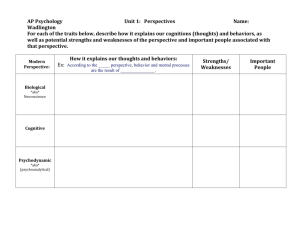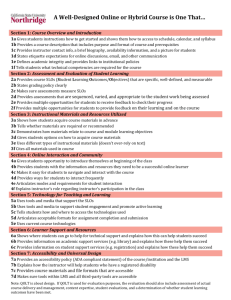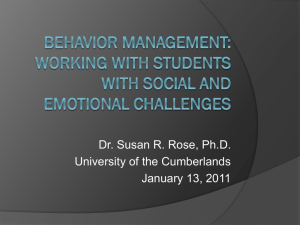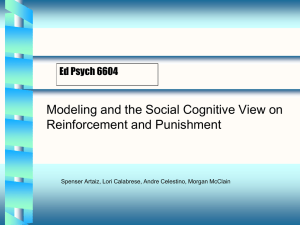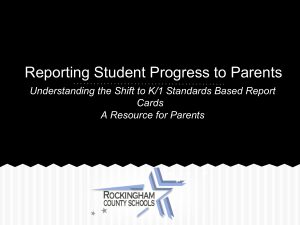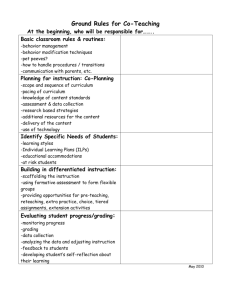Social Cognitive Theory Lesson Plan: Reinforcement & Modeling
advertisement
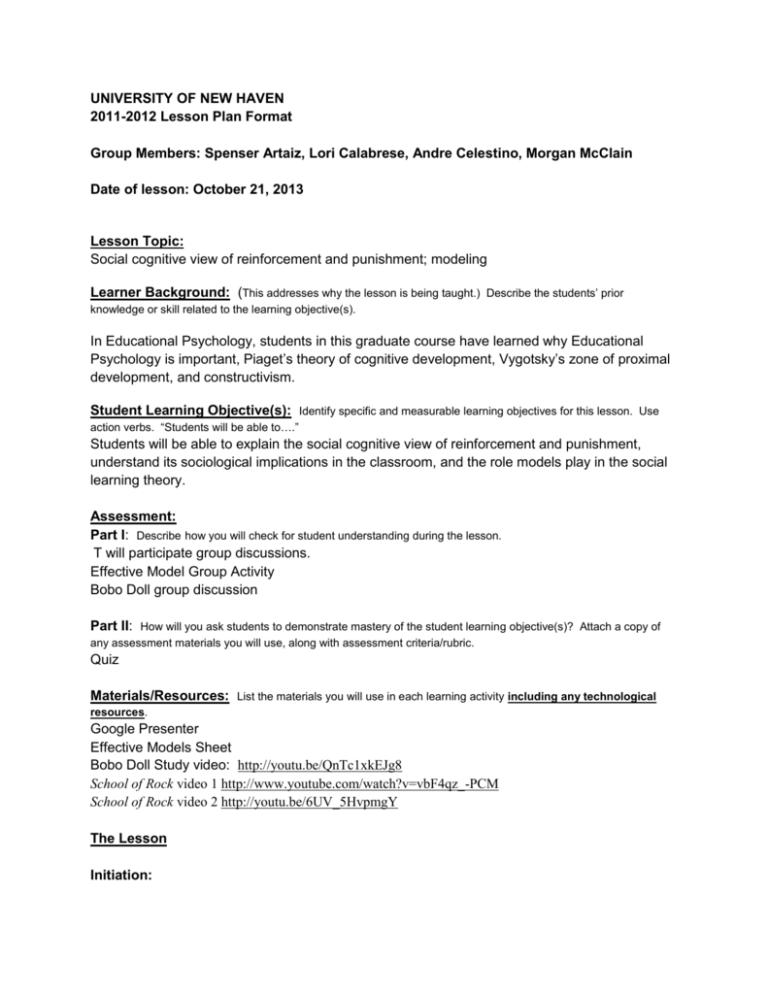
UNIVERSITY OF NEW HAVEN 2011-2012 Lesson Plan Format Group Members: Spenser Artaiz, Lori Calabrese, Andre Celestino, Morgan McClain Date of lesson: October 21, 2013 Lesson Topic: Social cognitive view of reinforcement and punishment; modeling Learner Background: (This addresses why the lesson is being taught.) Describe the students’ prior knowledge or skill related to the learning objective(s). In Educational Psychology, students in this graduate course have learned why Educational Psychology is important, Piaget’s theory of cognitive development, Vygotsky’s zone of proximal development, and constructivism. Student Learning Objective(s): Identify specific and measurable learning objectives for this lesson. Use action verbs. “Students will be able to….” Students will be able to explain the social cognitive view of reinforcement and punishment, understand its sociological implications in the classroom, and the role models play in the social learning theory. Assessment: Part I: Describe how you will check for student understanding during the lesson. T will participate group discussions. Effective Model Group Activity Bobo Doll group discussion Part II: How will you ask students to demonstrate mastery of the student learning objective(s)? Attach a copy of any assessment materials you will use, along with assessment criteria/rubric. Quiz Materials/Resources: List the materials you will use in each learning activity including any technological resources. Google Presenter Effective Models Sheet Bobo Doll Study video: http://youtu.be/QnTc1xkEJg8 School of Rock video 1 http://www.youtube.com/watch?v=vbF4qz_-PCM School of Rock video 2 http://youtu.be/6UV_5HvpmgY The Lesson Initiation: Part I - Briefly describe how you will introduce the lesson, engage students in the lesson and connect it to previous learning. (This is intended to motivate students.) T asks...Have you learned behaviors or skills from observing others? Maybe you have learned from observing a teacher, friend, or supervisor. We acquire new knowledge and skills from a variety of methods. This lesson will introduce the concepts of the social- cognitive theory, which focuses on the learning that occurs within a social context.Do you know how to do the Macarena dance? Come on...admit it. T plays the YMCA and models the dance! T says...Even if you aren't proud of knowing it, you probably learned the dance at some party or wedding you attended. T asks...Do you remember how you learned it? Ss answer question T explains...I doubt you read each step in a book and then tried it alone. You probably observed others dancing and then joined in when you thought you had a good understanding of the moves. There are many ways to gain new knowledge and learn behaviors and skills, and observation is one method. Part II – (This is intended to bridge to the lesson: set expectations for learning, articulate to learners what they will be learning in this lesson and why this is important). T says...This lesson will introduce the concepts of the social-cognitive theory which focuses on the learning that occurs within a social context. T shares a quote from Albert Bandura Lesson Development: Describe how you will develop the lesson: what you will do to model or guide practice and the learning activities students will be engaged in to gain the key knowledge and skills identified in the student learning objective(s). Include the questions you will ask, identify and explain the instructional grouping (whole class, small groups, pairs, individuals) for each lesson segment, and include the approximate times for each. Indicate how diversity will be included. Explicit Instruction: T defines Social Cognitive Theory Social Cognition: Theoretical perspective that focuses on how people learn by observing others and how they eventually assume control over their own behavior. T explains the assumptions of social cognitive theory: -people learn by observing others -learning is an internal process -behavior is directed toward specific goals -motivation makes the difference in success -behavior becomes self-regulated -reinforcement and punishment have several indirect effects on learning and behavior T explains social cognitive view on reinforcement and punishment: -People form expectations about possible consequences of a response based on how current responses are reinforced/ punished. -Learners often base outcome expectations on existing patterns of reinforcement, non-reinforcement and punishment. T explains vicarious experiences T explains Nonoccurrence of Expected Consequences -When expected rewards don’t happen, we perceive them as punishment. -If an expected punishment doesn’t happen, people often feel reinforced for the behavior -It increases the chances of the rule being broken again. -Teachers must follow through on promised consequences. T explains Modeling -Humans are born to imitate. -Observing others enables us learn many behaviors. -Some scientists think we’re pre-wired for imitation because of mirror neurons. -Mirror neurons in the brain become active when we observe others engaging in a behavior and when we engage in that behavior ourselves. -Our brain makes a connection between observing and doing. T explains 3 Types of Models Live models - real people we actually watch doing something. -can be a teacher, adult or other child. Symbolic models- real or fictional characters seen in TV/ film, books, media. Verbal Instructions- descriptions of how to successfully execute certain behaviors—without another human being. T will play the clip from School of Rock (video 1) http://youtu.be/vbF4qz_-PCM Group Activity: Effective Models -Write the names of five people you admire, whose behaviors you would like to imitate in some way. -Beside each name, write down at least one reason why you admire them. -Share them with your group. T explains Characteristics of Effective Models -Competence -Teacher should demonstrate competence if s/he wants children to model behavior -Prestige and power -Power may be demonstrated in socially appropriate or inappropriate ways -Gender appropriate behavior -Students choose behaviors to imitate based on whether they believe the behavior fits them or not. -Nontraditional models are useful to break stereotypes -Behavior relevant to the learner’s own situation -Information must be shown to be useful, practical to students T will play the second clip from School of Rock http://youtu.be/6UV_5HvpmgY T explains How Modeling Affects Behavior -Observational learning effect: when a child learns a new behavior after watching model. -Response facilitation effect: when a child displays a learned behavior more often after seeing model being reinforced for behavior. -Response inhibition effect: When a child displays a learned behavior less often after seeing model punished for that behavior. -Response disinhibition effect: When a child displays a forbidden behavior more often after seeing model do the behavior with no adverse consequences. T explains Successful Modeling -Attention: the learner must pay attention to the model. -Retention: the learner must remember what the model does. -Motor reproduction: the learner must be physically capable of reproducing the modeled behavior. -Motivation: the learner must be motivated to demonstrate the modeled behavior. T explains The Bobo Doll Experiment -This is a hot question today, but it was also of great interest 50 years ago when a psychologist, Albert Bandura, led an experiment to determine how kids learn aggression through observation. T shows video: http://youtu.be/QnTc1xkEJg8 T leads group discussion -Does the violence that children observe on television, movies, and video games lead them to aggressive behavior? Closure: Briefly describe how you will end the lesson, help students understand the purpose of the lesson, and show how it will connect to future learning. (Interact with learners to elicit evidence of student understanding of purpose(s) for learning and mastery of objectives) T says...Let's summarize what we've discussed. The social- cognitive theory focuses on the learning that occurs within a social context. Within this social context, learners observe new behaviors and skills from a model. They may internalize and demonstrate those skills or sometimes not. Social- cognitivists also believe people and their behaviors become self -regulated. Finally, observers form expectations about reinforcement and punishment based on what they observe happening to a model. It is also important to remember that models must be competent, are more effective if they are assumed to have power and prestige, and are engaging in relevant and gender- appropriate behaviors. T gives quiz on Google Presenter
